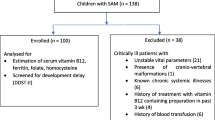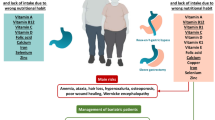Abstract
Aim of the Study
To determine iron status of healthy, unrelated Brahmin, Jain and Muslim participants having different dietary habits.
Methodology
Control participants other than above three communities, consumed vegetarian or non-vegetarian diet. Brahmin and Jain were strictly vegetarian but Jain did not consume roots or tubers. Muslims consumed non-vegetarian food. Standard techniques were used to measure hematological parameters, serum iron, total iron bindings capacity (TIBC), serum ferritin, transferrin and transferrin saturation. For statistical evaluation mean, standard deviation, pair t test, χ2 and ANOVA (F test) were employed.
Results
Study includes 565 male and 198 female children and adults. Among them 205 were children and remaining adults. All four categories i.e. control, Brahmin, Jain and Muslims showed higher incidence of anemia and iron deficiency in females compared to males. Mean values of hematological parameters did not vary significantly in four groups. Serum iron, TIBC, transferrin and ferritin levels indicated iron deficiency anemia more frequently in Jains and less frequently in Muslims (p<0.05). Iron status of Brahmin was comparable with controls (p<0.01). Majority of the participants had serum ferritin concentration >15 ng/mL. Except one male Jain child none of the participants had serum ferritin concentration <12 ng/mL. Jain subjects more frequently had serum iron concentration <60 μg/dL.
Conclusion
Jain participants had higher incidence of iron deficiency anemia. Vegetarian diet consumed by Gujarati Hindu Brahmin community provided them with a sufficient iron to maintain their iron profile like Muslims consuming non-vegetarian diet.
Similar content being viewed by others
References
A Report of the expert group of the ICMR: Nutrient requirements and recommended dietary allowances for Indians. National Institute of Nutrition, Hyderabad, ICMR, 1995; pp 43–49
Gopalan C, Sastri BVR, Balasubramamim SC, Navsingar Rao BS, Deosthale VG, Pant KC (1995) Nutritive value of Indian foods. National Institute of Nutrition, Hyderabad, ICMR 2–23:50
Brosovic M, Henhorn F (1995) Investigation of abnormal hemoglobins and thalassemia: Dacie JV, Lewis SM eds Practical hematology 8th ed, Edinburgh, Churchill Living stone, pp 249–285
Varley H, Gowenlock AH, Bell M (1980) Practical clinical biochemistry. 5th ed, London, William Heinm Ann Medical Books Ltd. pp 36–73
Daly LE, Bourke GJ, McGilvray J (1991) Interpretation and uses of medical statistics. 4th ed Oxford; Blackwell Scientific Publications, pp 139–156
Raman L, Sarma KVR (1996) Nutrition and anemia: Bamji MS, Rao NP, Reddy V. eds:Text book of human nutrition, New Delhi, Oxford and IBH Publishing Co. Pvt. Ltd., pp 266–286
Patel JC (1989) Prevalence of iron deficiency anemia in a village in Thana district and its treatment with iron fortified common salt. Indian J Hematol VIII:161–164
Bentley ME, Griffiths PL (2003) The burden of anemia among women in India. Eur J Clin Nutr 57:52–60
Totetja GS, Singh P, Dhillon BS, Saxena BN, Ahemd FU et al. (2006) Prevalence of anemia among pregnant women and adolescent girls in 16 districts of India. Food Nutr Bull 27: 311–315
Severson E, Buell JS, Fleming DJ, Bermudez OI, Potischman N et al (2007) Poor iron status is more prevalent in Hispanic than in non-Hispanic white older adults in Massachusetts. J Nutr 137:414–420
Mehta BC (2004) Iron deficiency amongst nursing students. Indian J Med Sci 58:389–393
Stoltzfus RJ (2003) Iron deficiency: global prevalence and consequences. Food Nutr Bull 24:S99–S103
Mehta BC (1982) Thalassemia and nutritional anemia interaction: Bhatia HM, Contractor NM eds: Recent trends in Immunohaematology, Bombay, ICMR 134–140
Shah A (2004) Iron deficiency anemia — Part I. Indian J Med Sci 58:78–81
Vishwanath D, Hegde R, Murthy V, Nagushree S, Shah R (2001) Red Cell distribution width: Sensitive parameter of iron deficiency anemia? Indian J Pediatrics 68: 1117–1119
Worwood M (2001) Iron deficiency anemia and iron overload: Levis SM, Bain BJ, Bates I Ed. Practical Haematology. 9th ed, London: Churchill Livingstone 115–128
Beard JL, Murray-Kolb Le, Rosales FJ, Solomaons NW, Angelilli ML (2006) Interpretation of serum ferritin concentrations as indicators of total-body iron stores in survey population: the role of biomarkers for the acute phase response. Am J Clin Nutr 84:1498–1505
Author information
Authors and Affiliations
Corresponding author
Rights and permissions
About this article
Cite this article
Bhatti, A.S., Mahida, V.I. & Gupte, S.C. Iron status of Hindu brahmin, Jain and Muslim communities in Surat, Gujarat. Indian J Hematol Blood Transfus 23, 82–87 (2007). https://doi.org/10.1007/s12288-008-0004-0
Published:
Issue Date:
DOI: https://doi.org/10.1007/s12288-008-0004-0




